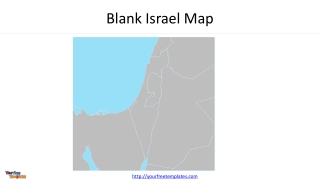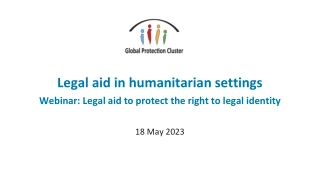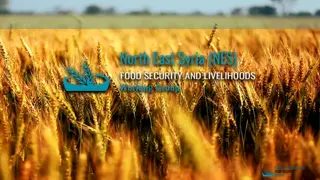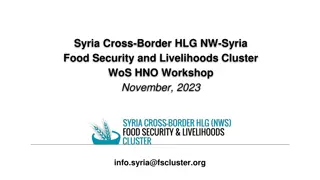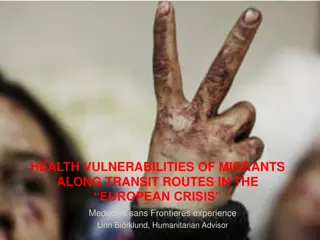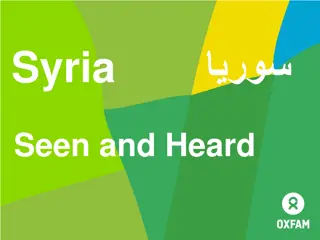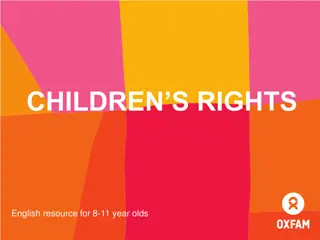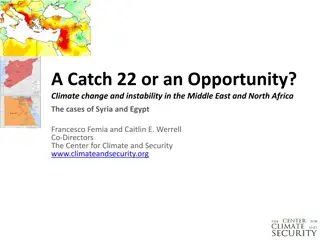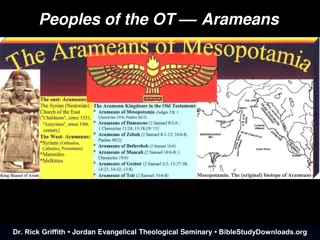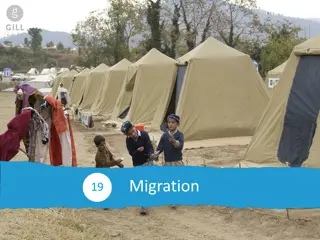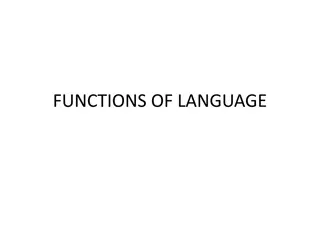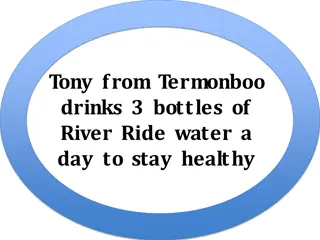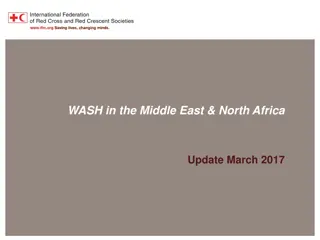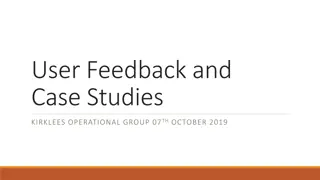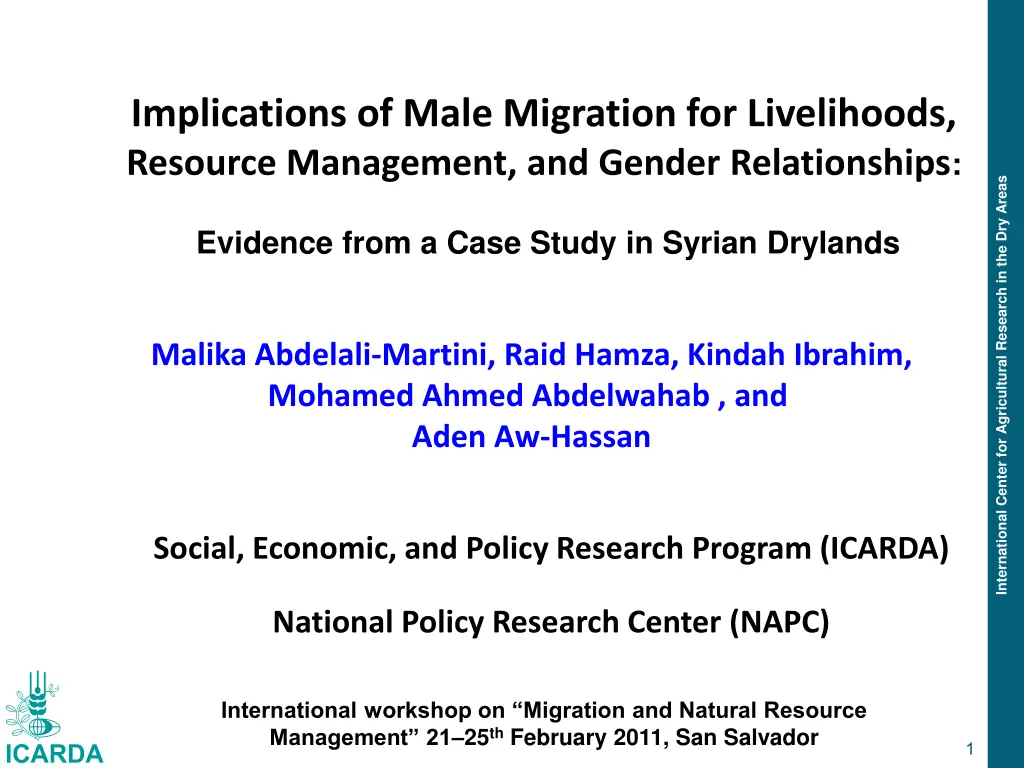
Implications of Male Migration for Livelihoods and Resource Management in Syrian Drylands
Explore the impact of male migration on livelihoods, resource management, and gender relationships in the dry areas of Syria. The study focuses on the challenges and potential solutions in sustainable resource management, soil conservation, and addressing converging trends in dryland regions.
Download Presentation

Please find below an Image/Link to download the presentation.
The content on the website is provided AS IS for your information and personal use only. It may not be sold, licensed, or shared on other websites without obtaining consent from the author. If you encounter any issues during the download, it is possible that the publisher has removed the file from their server.
You are allowed to download the files provided on this website for personal or commercial use, subject to the condition that they are used lawfully. All files are the property of their respective owners.
The content on the website is provided AS IS for your information and personal use only. It may not be sold, licensed, or shared on other websites without obtaining consent from the author.
E N D
Presentation Transcript
Implications of Male Migration for Livelihoods, Resource Management, and Gender Relationships: International Center for Agricultural Research in the Dry Areas Evidence from a Case Study in Syrian Drylands Malika Abdelali-Martini, Raid Hamza, Kindah Ibrahim, Mohamed Ahmed Abdelwahab , and Aden Aw-Hassan Social, Economic, and Policy Research Program (ICARDA) National Policy Research Center (NAPC) International workshop on Migration and Natural Resource Management 21 25th February 2011, San Salvador 1
Study Area International Center for Agricultural Research in the Dry Areas Jabel El-Hoss Sam an Jabel El Hoss Sfireh Sfireh irrigated from canals 2
Study Area International Center for Agricultural Research in the Dry Areas 3
The Study Area Jabal al-Hoss is one of the poorest areas in Syria Jabal al-Hoss with its 157 villages is one of the poorest areas in Syria The villages have the shape of mud domes Life is harsh, given the rocky surface of the land and the dry climate Yet there is potential in rural areas, that can be supported by external funding
Sustainable Resource Management Conservation of NR: Soil conservation in drylands Improved range management in pastoral areas Land degradation and sustainability in dry areas This could be through: Support to local resource-user groups; Better management practices Improved long-term policies.
Drylands face a number of converging trends High population growth rates of up to 3% Regions that are already water scarce and will be increasingly so, (climate change predictions: regions become hotter and drier) Increasing dependency on grain imports Increasing desertification and loss of biodiversity Increasing out-migration of males from rural areas Problems of access to international markets
Soil Climate Jabal Al-Hoss is a gently undulating plain Long, hot and dry summers Rain falls Sept-May, with peak during Dec-Jan Basaltic on hills, forming gently rolling plateaus Long term annual rainfall is appr. 220 mm, reduces towards the steppe Slopes covered with stones, and incised with v-shaped erosion channels High variability of annual and inter-annual rainfall Soils on slopes are of variable thickness, but generally shallow (<1 m-16 m, well drained with high infiltration capacity
Major Economic Activities Majority of the population involved in agriculture Three main types of agricultural production systems Rainfed farming Irrigated farming and livestock Rearing
Major economic activities cont Combination of crop production and livestock rearing Barley as the dominant crop, occupies the major part of the arable land Off-farm activities are very important in providing sufficient income in this resource-poor area About 43% of hhs have one or more members working as off-farm labor, 15% of hhs have members working as labor in cities, and 16% of hhs have members working outside Syria
Environmental/ Economic Constraints Rainfall is not sufficient to grow rainfed crops Large number of wells to supplement rainfall Upper aquifer system receives little recharge Groundwater table has gone down Most households buy drinking water from the government pipeline
Livelihood Strategies Tendency to diversify sources of income due to increasing uncertainty of the local socio-economic and ecological environment Dominant livelihood types: Livestock-crop farmers Pastoralists Off-farm laborers Without a real awareness about threats of climate change, many do invest in their natural resources, and assets
International Center for Agricultural Research in the Dry Areas Why focus on rainfed areas? How migration is already impacting on agricultural & rural development? What are the positive/ negative effects of migration? How can the government capitalize on the opportunity that migration offers? 14
Sample Selection International Center for Agricultural Research in the Dry Areas Differences in farming systems Irrigated versus rainfed systems Agro-ecological zones Marginal (zone 3) versus more favorable environments (zone 2) Development project versus no development project (UNDP, IFAD, Gov of Syria) Total population in the study area 15
Research Problem Migration often involves male household members seeking employment in agriculture, non-farm jobs cities & abroad. International Center for Agricultural Research in the Dry Areas The economic and social impact of migration is not known. That depends on: the social and cultural context and the strength of the social connection between the migrants and families at origin The institutional and policy framework that support savings and investment
Research Problem cont International Center for Agricultural Research in the Dry Areas Migration provides remittance income, knowledge with positive impacts on rural economies But remittances may not have lasting development impact due to: Direction of remittances to consumption Weak local investment opportunities in the communities of origin OR lack of supportive savings & investment policies It is critical to understand the institutional environments and social networks that affect these financial flows and how they can be directed to agricultural and rural development
The ConceptualFramework Gender NRM International Center for Agricultural Research in the Dry Areas Tradition/customs, local perceptions Type of resource Resource size Gender-based roles & activities Livelihoods Resource condition Decision-making Disparities in access & control over NRM Management Investment Effects on NRM management Migration Productivity Who migrates? where, when and for how long Determinants of migration Push factors Pull factors Benefits of migration Remittances
Push Factors of Migration International Center for Agricultural Research in the Dry Areas Unemployment Non ownership of assets: land, livestock, Population pressure, land fragmentation Low income from agriculture, particularly, rainfed agr. Insufficient income to meet basic household needs Lack of capital to repay debts Drought risk, causing crop failures, debt and loss of income low prospects for improving living standards
Pull Factors of Migration International Center for Agricultural Research in the Dry Areas Better wages: Non-agricultural versus agricultural work Abundance of job opportunities in cities and abroad High prospect of getting work Chance to achieve better living standards
Types of Migration DEFINITION: Migrants are HH members who lived outside home for work for any period of time over the last 12 months (continuous or non-continuous). International Center for Agricultural Research in the Dry Areas Daily commuting is not considered as migration, but considered as off-farm work; Permanent migration/ relocation is not considered Internal migration: Rural-urban migration Rural-rural migration External Migration: Neighboring countries (Lebanon, Jordan) OTHER COUNTRIES (Saudi Arabia, Cyprus)
Methodology Participatory Rural Appraisal in 10 villages A checklist of 113 questions for the PRA Questions pertained to migration, its patterns, causes, types of migrants, impacts of migration, remittances, livelihoods, work, non-farm rural activities, agricultural technologies, community activities, natural resource management, considering land, water, rangelands, biodiversity products livestock, development projects in the area and their impact Formal survey
Sample Selection and Size - Questionnaire A priori decision - 25% of the villages in Jabal El-Hoss and Sfireh areas located in Aleppo Governorate A sample of 32 villages was randomly selected from a total of 120 villages Questionnaire designed based on PRA information tested Questions addressed to men Questions addressed to women
Description of the sample Jabal El-Hoss (Samaan) N (%) 91 (47.4) Jabal El-Hoss (Sfireh) N (%) 95 (49.5) Sfireh (Canal Irrigation) N (%) 6 (3.1) Total N (%) Area HHs with migrants 192 (32%) (100) HHs w/out migrants 156 (37.5) 88 172 (41.3) 416 (68%) (100) (21.2) Total HHs 247 (41) 183 (30) 178 (29) 608 (100) Migrants 150 (43) 191 (55) 8 349 (100) (2) Men Wom. Men Wom. Men Wom. Men Wom. Men vs women 139 11 153 38 8 0 300 (86) 49 (14)
Migrants distribution Male N (%) 139 Female N (%) 11 Total N (%) 150 Area Jabal El-Hoss (Samaan) (43) 153 38 191 Jabal El-Hoss (Sfireh) (12.5) 8 0 8 Sfireh (Canal Irrigation) (2.3) 300 49 Total migrants 349 (100) (86) (14)
Land area (means) by type of households and target area HHs with migrants N = 155 59 HHs w./out migrants N = 334 57 Land - Means (du) JEH Samaan JEH Sfireh Sfireh irrigated N = 122 42 N = 209 64 N = 158 62 Land Means (du)
Type of work performed by migrants and daily commuters Type of movement /migration Commuting /daily movement Men Women Loading, construction, loading, sewing Weeding, harvesting Internal migration Damascus, Aleppo, other cities Loading/ porters, construction /building, mechanic workshop, electrician, carpenters, traders (hawkers), lifting grain bags at governmental stores Most in services and construction Construction, hawkers, drivers, traders (hawkers), daubing (painter)*, car washing, porters Construction, loading, cleaning, car washing, apple picking Weeding, harvesting, vegetable collection, straw collection External migration Lebanon / Jordan Sharecropping Weeding/ harvesting Saudi Arabia, Cyprus, Libya, Greece *Few migrants invested their remittances in machines to dig wells
i. Who migrate ? Less endowed households who lack physical assets: land holding size, irrigated and trees areas, number of sheep and goats Low return from rainfed crop returns, particularly during drought years Diversification of agricultural income sources (through irrigation) Number of income sources As a result, the more the households are equipped with productive assets, the less their members have a propensity to migrate
Contribution of Women and Men to Livestock Production Dairy sheep Sheep fattening Goat production Cow production % % % Target area Women Men Women Men Women Men Women Men J. El-Hoss Samaan 73 27 69 31 77 23 71 29 J. El-Hoss Sfireh 79 21 73 27 82 18 90 10 Sfireh (canal irrigation) 74 26 79 21 74 26 55 45 75 25 72 28 78 22 77 23 Total
Main Sources of Income (%) in our sample Area Crop Prod. Livest.k Off- Farm Wage 3.4 Non- Agr.Wage Self- Employ- ment 4.4 Remittan- ces Daily Commu- ting 10.1 Un- earned J.El-Hoss (Samaan) 20.4 18.4 22.9 19.5 0.9 J. El-Hoss (Sfireh) 19.8 20.8 4.2 13.7 2.8 34.9 3.1 0.7 Sfireh Irrigated 68.9 10.5 2.3 14.9 1.7 1.1 0.4 0.2 Total Sample 39.8 15.9 3.2 17 2.8 16.5 4.2 0.6
Main Findings 1. Migration improves the livelihoods of people living in rainfed areas 2. Remittances increase the productivity and efficiency of natural resource use 3. Remittances have contributed to the expansion of rainfed areas 4. Land reclamation improves the livelihoods of people in rainfed areas 5. Male Migration does not increase women s work in rainfed areas 6. Male migration, particularly married /head of HH, negatively affects children education, specially boys
(1) Migration improves the livelihoods of people living in rainfed areas For the whole sample in the research area (rainfed and irrigated) remittances represent 15% of the income: Its share is much higher for rainfed areas: 27% But low in irrigated areas: 1% In households with migrants, remittances contribute on average with 49.5% to the total income 55.6% in the households income in rainfed areas and 37.3% in households income in irrigated areas
Migrant HHs = 192 Non-migrant HHS = 416
Migrant HHs = 192 Non-migrant HHS = 416 346 341 197
Factors affecting the annual per capita income Factors affecting positively per capita income Number of migrants: Increase by 1 migrant per HH results in increasing the PCI by 859 SP/year Education of household head Irrigated areas Tree area Size of sheep and goats owned Additional income sources (diversification) would increase PCI by 2900 SP/ year Factors negatively affecting per capita income Number dependents: An additional dependent member in the family (Dependency ratio) reduces per capita income by 2323 SP/year This suggests attention on mothers education, health, and awareness Remittances contribute to lowering the gap between the different types of households. In other words, remittances play a major role in the improvement of livelihoods of the poor
Most of the actual expenditures are still concentrated in households daily expenditures / and consumption, with small amounts devoted to crops, inputs, livestock and non-agricultural businesses
Results about their wishes for investments indicate strong willingness to invest in livestock production and other non-farm businesses Results about their wishes for investments indicate strong willingness to invest in livestock, and crop production, then other non-farm businesses
Investments of credits in NRM by households with and without migrants (%) 25 22.4 19.7 20 18.2 16.8 15.6 15 % 10.4 10 6.7 6.3 6.3 5 3.6 2.6 1.7 1.6 0.5 0 Migrants HHs Non-migrants HHs
Factors that increase the likelihood of migrants sending more remittances Land ownership . Migrants are likely to invest more in expanding/ increasing and improving the available assets Rainfed areas, low potential for crop production. Migrants from rainfed areas send more remittances - low agriculture returns in these areas Investment in livestock. There is a likelihood of migrant to invest in livestock as a source of livelihood especially in rainfed areas where the potential of production is high Female headed households and large families. The amount of remittances received rises when the head is female Results indicate that the lower the education level, the higher the remittances amounts sent. Most migrants destination is Syrian cities and neighboring countries, performing activities where they have acquired expertise without formal education
(2) Remittances increase the productivity and efficiency of natural resource use Based on production efficiency model: On an average, 67% of the households with migrants are operating at high level of efficiency in cereal production thus using resources (land, water and inputs) effectively; but only 58% for the households without migrants Yield increase in cereals is higher by 20% within migrants households as compared to non-migrant households In general, migrant households apply 10% more farm inputs (fertilizer, manure, and seeds) compared to non-migrant households This can be explained by the role of remittances to reduce the financial constraints The higher the number of migrants, the higher the efficiency and productivity of NR through additional inputs and management practices
(2) Remittances increase the productivity and efficiency of natural resource use con t Factors that improve the efficiency of NRM (mainly cereals) Use of improved irrigation techniques The higher the household head education, the better the efficiency of crop management Factors that reduce the efficiency of NRM (mainly cereals) Sloppy lands are limiting farmers from growing specific crops Therefore, replacing cereals by trees on sloppy lands would result in the improvement or increase of the overall efficiency of NR use
(3) Remittances have contributed to the expansion of rainfed areas Migration and remittances have played a major role in land reclamation Remittances have contributed to the expansion of rainfed areas Likely that the tree area previously planted through State support on de-stoned lands, has encouraged farmers to do more land reclamation and probably plant more trees But farmers are concerned about: The long term it takes to realize return from trees (turnover) The high irrigation cost of trees with purchased water (60.3% of farmers) Farmers express the need for greater support while trees are non productive Data on land in 2000 and 200922
(4) Land reclamation improves the livelihoods of people in rainfed areas, 1. Participation in land reclamation contributes to increase PCI by 7170 SP/year (156 US$) Large planted area Feasible for more chemical inputs and machinery Higher income from field crops and trees 2. The higher the total male migrants of a household, the more likely the household has benefited from land reclamation (sig. 1%)
(4) Land reclamation improves the livelihoods of people in rainfed areas con t De-stoning - done through development projects & private initiatives has increased HH wealth and incomes Constraints to benefiting from land reclamation is lack of formal land titles of smaller landholdings: Property rights of these lands are defined by customary property rights Development projects and the state require property titles to qualify for land reclamation loans, and to access other formal credits Despite all these limitations . THEY ARE INVESTING IN LAND RECLAMATION Property rights TITLES constitute a big barrier to benefit from development initiatives, although mukhtar delivers a certificate attesting land ownership
(5) Male migration does not increase womens work load Surplus of male labor in rainfed areas constitute bulk of migrants Migrants return to village during peak labor demands (work in Syrian cities, Lebanon and Jordan) The more income sources in the household, the more likely women contribute to additional work and responsibilities Results indicate that the likelihood of women s work increase is higher in irrigated areas, due to the intensive cropping, but not to males migration In irrigated areas migration is feminizing agriculture, but not in rainfed areas The absence of men from poor households or landless does not seem to lead to greater autonomy of women, nor does it affect decision-making within the household 1. 2. 3. 4. 5. 6.
(5) Male migration does not increase womens work load in rainfed areas con t 1. Most migrants are poor households mainly located in rainfed areas 2. Crop production is limited to cereals and legumes 3. Cereals in rainfed areas is mostly mechanized and women s work concentrate on the limited legume areas 4. Women from rainfed areas work off-farm in agriculture in areas where irrigation is spread and intensified agriculture /high demand for agricultural labor 5. Livestock production is important and women perform related activities up to 80%, men do 20% of the work mainly providing feeds to animals from different sources, and marketing dairy products, live animals and other related products
ii. (6) Male migration negatively impacts on children education 1. Drop of children from schools 2. Mother perspectives on managing boys in school age 3. Role model
RECOMMENDATIONS Evidence shows that lack of land property titles constrains access to government land reclamation programs and formal loans 1. Facilitate land titles to encourage the use of remittances in land improvement investment This will increase income, household s food security But, the risk due to drought should be taken into consideration for example through insurance There is clear evidence that small ruminant production is the most favored investment of remittances; there is also evidence that the landless, who are the poorest, rely mainly on small ruminants, besides local people have deep knowledge of the sector, which is a high value sector with increasing demand. Therefore: 2. The investment in small ruminants should be encouraged by a program where investment of remittances is matched by government financial support This will direct the financial flows from remittances to the productive sector of the poor Technologies for processing and adding value such as cheese and yogurt need to be introduced This will enhance household food security, increase income and reduce poverty

